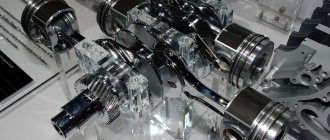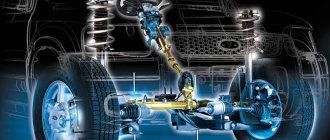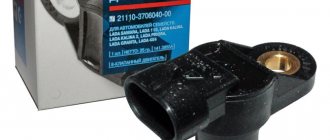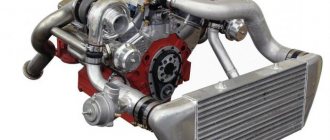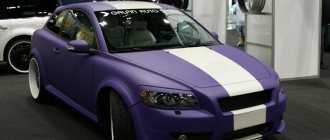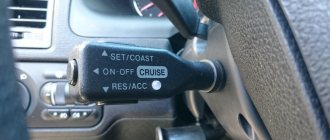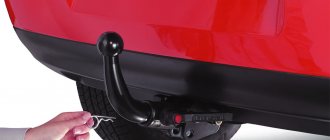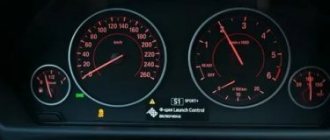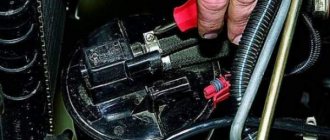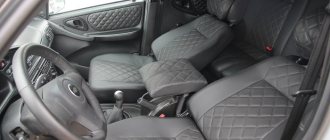Spoiler and wing
A spoiler is a part that changes the free flow of air. A rear spoiler is a body element that is installed at the rear of the car (on the trunk lid or roof). The spoiler has no gap with the body. If there is a gap, then this is already a wing. As the name suggests, a rear spoiler interferes with air flow, altering the fast, smooth flow coming from the roof. By blocking the air flow, the spoiler changes it, reduces the speed of air flow and creates pressure on the rear, preventing it from lifting. This is one of the functions of a spoiler. Also, spoilers designed specifically for specific cars can reduce the overall air resistance created by the car.
On the left is a wing, on the right is a spoiler.
The wing creates downforce at the rear of the car. A wing is essentially an inverted airplane wing. An airplane's wings generate lift, which helps it take off. The wing acts the same, but since it is an inverted wing, downforce is generated. Hence the name (wing - for take-off, wing - for pressing down). The wing of an airplane and the wing have different angles of attack. The wing has a negative angle of attack. To put it simply, the air flow puts more pressure on the upper part of the wing, and on the lower part of an airplane wing.
In English, where the word “spoiler” actually comes from, there is no name “wing”. There, such a body element is called a “wing”. At the same time, many also in everyday life call all tuning elements installed at the rear of the car (and not only) spoiler. Although, the word “wing” itself reveals the meaning of this device and does not cause confusion. Wing - the opposite wing (inverted wing).
Types of tuning elements
There is a division of spoilers into types according to different criteria: style, location on the body and material.
- By style
- factory - manufactured at a factory that produces car tuning elements or manufactured independently, but according to the dimensions of factory products;
- individual - a factory spoiler produced in small quantities, or self-production according to individual sizes and design.
Unfortunately, a custom-style spoiler can, on the contrary, ruin the existing aerodynamics of the body.
- By location by car
- The most common rear spoiler. Mounted on the trunk lid.
- Roof spoiler. Installed on the roof of the car.
- Skirts. Mounted on bumper skirts or side skirts.
- By type of material (ideally: durable, lightweight, wear-resistant)
- fiberglass (fiberglass) is a plastic material with admixtures of resin additives and fiberglass. The most budget option among tuning parts, which does not affect its characteristics.
- ABS plastic. Brittle material requiring strengthening additives and impurities. Wear resistance suffers greatly;
- silicone materials are a new type of material for tuning. Its advantage is elasticity, durability, resistance to deformation;
- carbon (carbon fiber) – gives excellent aerodynamic properties to the car, but the cost is quite high;
- Light metals are an unprofitable and pointless one-piece production, so they are used in parts: blades, struts, flaps.
%rtb-4%
What is the difference between a wing and a spoiler?
In a broad sense, a wing is also a spoiler, but with a special configuration and a specialized function. The wing, like all spoilers, interferes with the free flow of air and changes this flow. The only function of the wing is to generate downforce.
The functions of a spoiler can be different, depending on where on the body it is installed and what shape it has. One of the functions of the rear spoiler is to prevent the rear of the body from lifting up. It performs this function by creating a barrier to free flow. The air presses on the spoiler and the rear part is pressed. Also, the spoiler can adjust the shape of the body, improving aerodynamics.
On bodies where the roof ends and there is no smooth continuation in the form of glass and trunk lid (on hatchbacks, minivans, etc.), turbulence is created. This increases the overall resistance and slows down the car. A properly designed spoiler (see illustration) can reduce this effect, which will subsequently affect fuel consumption. But this can only be noticed during long, high-speed movements along the highway. At 120 km/h and above, 50% of the fuel is spent on overcoming air resistance. Thus, by reducing resistance, you can get significant savings in fuel consumption. Unlike a wing, a spoiler does not require precise adjustment during installation.
Spoiler price
As already mentioned, the cost of a spoiler largely depends on the material from which it is made. For example, a regular plastic spoiler will cost from 4,000 rubles for a 2000 Audi A4. For a BMW X5 (E70), a spoiler made of ABS plastic will cost from 6,000 rubles. Popular manufacturers include Remin, Pure, JKS, Dawn, tSi.
If you cannot decide to install it yourself, then you can always contact specialists at special service stations. The average cost of installation will depend on the complexity of attaching the spoiler; the one with adhesive tape will cost less. Installation will cost about 20 euros, but with bolts it will cost from 30 euros. The average installation time on adhesive tape is from 30 to 60 minutes, on bolts from 60 to 120 minutes.
As a conclusion, before purchasing, you should decide on the method of mounting the spoiler, then the material from which it will be made, and the amount you are willing to pay for the pleasure.
Spoiler installation video:
The question arises, why press the car to the road?
At high speeds (over 120 km/h), the air blown under the car begins to lift it (starting from the rear), like a giant wing. Because of this, handling deteriorates, especially when cornering. So, if you try to turn the car at high speed, the car may fly off the road. The only way to reduce the car's lift at speed is to increase its weight. The problem with adding weight to improve traction is that it doesn't help in corners, when traction is needed most. The extra weight has inertia that must be overcome in order to turn. In addition, due to the additional weight, fuel consumption increases. Thus, increasing the weight of the car for better traction is a failed path.
The rear wing is precisely the device that helps press the car to the road at high speeds.
Its advantage is obvious. Instead of a heavy, clumsy car, you can drive a car with a light weight, which is easy to control and the higher the speed, the more force it is pressed to the road. But there is one thing. Every time a wing generates downforce, it also generates drag. Air resistance slows down the car. Thus, additional downforce is good, but too much downforce gives a lot of drag, which is bad. Very powerful sports cars that compete in Formula 1 have something called an L/D ratio. Automotive designers are trying to increase this figure so that the car hugs the road well enough without slowing down.
Flaws
Disadvantages only occur if this element is installed incorrectly. An incorrect position relative to oncoming air flows will significantly worsen aerodynamics, air resistance will increase, and this will lead to additional fuel consumption. Also, in case of loss of controllability, it is much more difficult to straighten the car, and at high speeds, the clearance between the road and the bottom will greatly decrease. This is dangerous on bad roads. All these shortcomings are clearly visible in plastic car spoilers.
Examples of the use of wings by manufacturers of powerful cars
For example, you can take the Koenigsegg ccx. This is a car with a 4.8 liter engine producing more than 750 horsepower. The weight of this machine does not exceed 1 ton. It's not a bad car, but it has gained a reputation for being uncontrollable at high speeds. The lack of a rear spoiler, coupled with its light weight, made this supercar unstable at speed and turning corners at speed was terrifying. After lengthy criticism, the company released a new model with a rear wing installed.
Here's another example. When the first versions of the Audi TT were released, a whole series of road accidents were recorded due to insufficient grip while cornering at speed, including on wet roads. There was also an incident with a famous German racing driver who died in an Audi TT. After these incidents, all Audi TTs sold were recalled and a wing was installed on each of them. The following models of this car already had an electronically controlled wing that extended when reaching high speed.
An example of rear end stabilization with a spoiler is the LeMans winner Ford GT40. Its first testing at high speed showed that the rear part behaves unstably and “wobbles”. The higher the speed, the worse this “wobble” can end. The problem was solved by installing a small spoiler on the rear of the trunk.
A Formula 1 car at a speed of 300 km/h, due to its wing, generates downforce equal to the weight of a small car. Pressing too hard is also not good. For this reason, the Bugatti Veyron and McLaren P1 have retractable wings. They extend when supercars reach speeds of 120 km/h to prevent them from flying off the road and retract slightly when the car reaches 250 km/h to prevent the enormous downforce from damaging the rear suspension. To generate downforce, the wing must have a slope (angle of attack). The high-speed flow coming off the roof towards the rear of the car will be blocked by a wing, which in turn will create downforce.
Vertical flat elements on the sides of the wing prevent air from "spreading" over the sides and, in some cases, can increase the efficiency of the wing by 30%.
If the wing is not designed correctly, it can provide unnecessary resistance and not “press” the car. Typically, manufacturers of spoilers and wings develop their products for specific car models. Many are more concerned not with the stability of handling and traction at high speeds, but with the sporty look that these tuning elements create.
It is important that the wing is installed at the correct angle.
Correct, professional installation of a wing requires about 3 hours of testing and adjustment in a wind tunnel. An incorrectly installed wing can harm the car's aerodynamics and increase air resistance. Also, too much downforce at the rear of the car may be generated, which is also bad and will impair handling.
